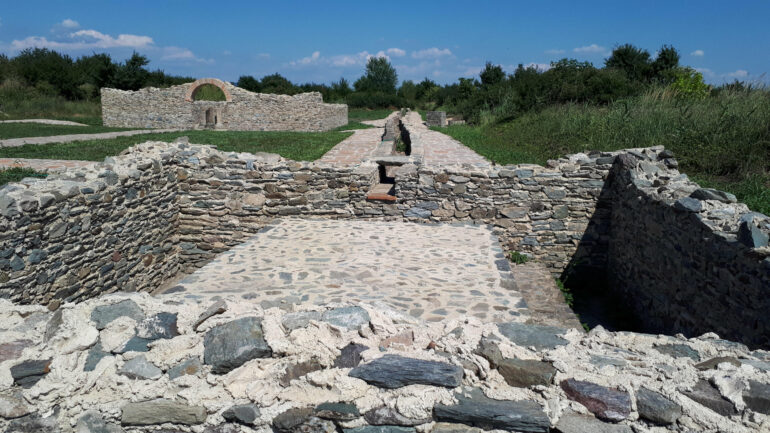A multidisciplinary study has reconstructed the genomic history of the Balkan Peninsula during the first millennium of the common era, a time and place of profound demographic, cultural and linguistic change.
The team has recovered and analyzed whole genome data from 146 ancient people excavated primarily from Serbia and Croatia—more than a third of which came from the Roman military frontier at the massive archaeological site of Viminacium in Serbia—which they co-analyzed with data from the rest of the Balkans and nearby regions.
The work, published in the journal Cell, highlights the cosmopolitanism of the Roman frontier and the long-term consequences of migrations that accompanied the breakdown of Roman control, including the arrival of people speaking Slavic languages. Archaeological DNA reveals that despite nation-state boundaries that divide them, populations in the Balkans have been shaped by shared demographic processes.
“Archaeogenetics is an indispensable complement to archaeological and historical evidence. A new and much richer picture comes into view when we synthesize written records, archaeological remains like grave goods and human skeletons, and ancient genomes”, said co-author Kyle Harper, a historian of the ancient Roman world at the University of Oklahoma.
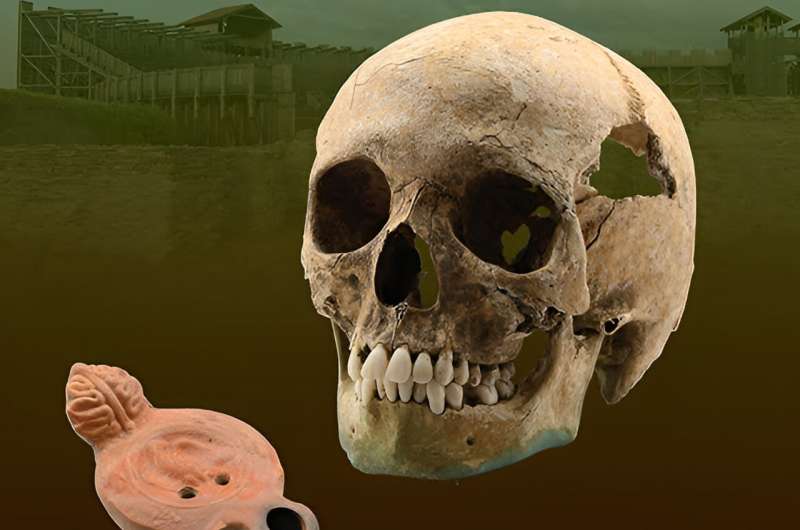
The skull of the East African individual plus the oil lamp with the legionary eagle that he was buried with. © Miodrag Grbic
Massive demographic influx into the Balkans from the East during the Roman Empire
After Rome occupied the Balkans, it turned this border region into a crossroads, one that would eventually give rise to 26 Roman Emperors, including Constantine the Great, who shifted the capital of the empire to the eastern Balkans when he founded the city of Constantinople.
The team’s analysis of ancient DNA shows that during the period of Roman control, there was a large demographic contribution of people of Anatolian descent that left a long-term genetic imprint in the Balkans. This ancestry shift is very similar to what a previous study showed happened in the megacity of Rome itself—the original core of the empire—but it is remarkable that this also occurred at the Roman Empire’s periphery.
A particular surprise is that there is no evidence of a genetic impact on the Balkans of migrants of Italic descent: “During the Imperial period, we detect an influx of Anatolian ancestry in the Balkans and not that of populations descending from the people of Italy,” said Íñigo Olalde, Ikerbasque researcher at the University of the Basque Country and co-lead author of the study.
“These Anatolians were intensively integrated into local society. At Viminacium, for example, there is an exceptionally rich sarcophagus in which we find a man of local descent and a woman of Anatolian descent buried together.”
The team also discovered cases of sporadic long-distance mobility from far-away regions, such as an adolescent boy whose ancestral genetic signature most closely matches the region of Sudan in sub-Saharan Africa and whose childhood diet was very different from the rest of the individuals analyzed. He died in the 2nd century CE and was buried with an oil lamp representing an iconography of the eagle related to Jupiter, one of the most important gods for the Romans.
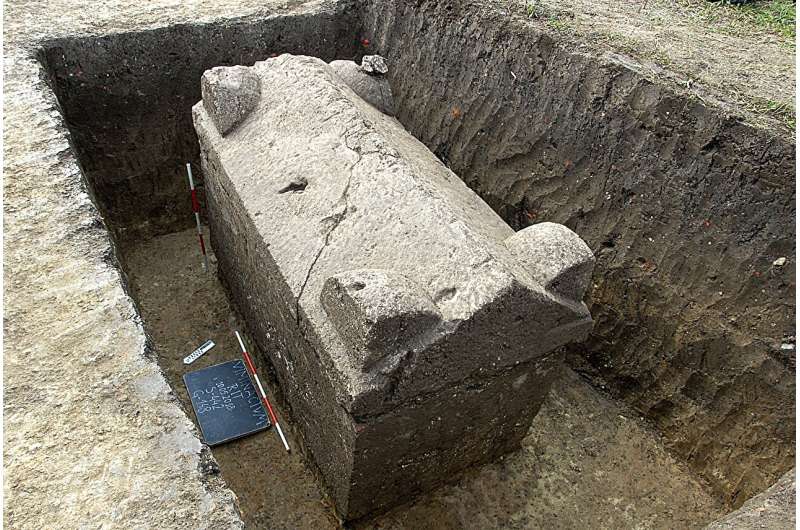
Exceptionally rich sarcophagus found at Viminacium in which a man of local descent and a woman of Anatolian descent were buried. It features several gold and silver objects including two gold earrings, a silver mirror, a silver brooch and 151 gold beads. © Ilija Mikić.
“We don’t know if he was a soldier, slave or merchant, but the genetic analysis of his burial reveals that he probably spent his early years in the region of present-day Sudan, outside the limits of the Empire, and then followed a long journey that ended with his death at Viminacium (present-day Serbia), on the northern frontier of the Empire,” said Carles Lalueza-Fox, principal investigator at the Institute of Evolutionary Biology and director of the Museum of Natural Sciences of Barcelona.
The Roman Empire incorporated ‘barbarian’ peoples long before its collapse
The study identified individuals of mixed Northern European and Pontic steppe descent in the Balkans from the 3rd century, long predating the final breakdown of Roman imperial control.
Anthropological analysis of their skulls shows that some of them were artificially deformed, a custom typical of some populations of the steppes, including groups labeled by ancient authors as “Huns.” These results reflect the integration of people from beyond the Danube into Balkan society centuries before the fall of the Empire.
“The borders of the Roman Empire differed from the borders of today’s nation-states. The Danube served as the geographic and military boundary of the Empire. But it also acted as a crucial communication corridor that was permeable to the movement of people attracted by the wealth Rome invested in its frontier zone,” said co-author Michael McCormick, Francis Goelet Professor of Medieval History at Harvard University.
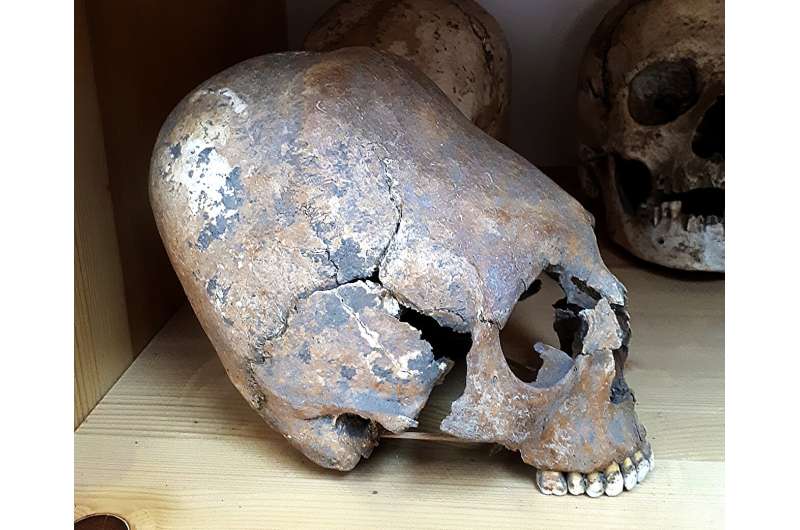
Deformed skull dated to the 4th century CE, attributed to an individual from the steppes. Originally labeled by archaeologists as possible Gepid or Goth. © Carles Lalueza-Fox.
Slavic populations changed the demographic composition of the Balkans
The Roman Empire permanently lost control of the Balkans in the sixth century, and the study reveals the subsequent large-scale arrival in the Balkans of individuals genetically similar to the modern Slavic-speaking populations of Eastern Europe. Their genetic fingerprint accounts for 30-60% of the ancestry of today’s Balkan peoples, representing one of the largest permanent demographic shifts anywhere in Europe in the early medieval period.
The study is the first to detect the sporadic arrival of individual migrants who long preceded later population movements, such as a woman of Eastern European descent buried in a high imperial cemetery. Then, from the 6th century onwards, migrants from Eastern Europe are observed in larger numbers; as in Anglo-Saxon England, the population changes in this region were at the extreme high end of what occurred in Europe and were accompanied by language shifts.
“According to our ancient DNA analysis, this arrival of Slavic-speaking populations in the Balkans took place over several generations and involved entire family groups, including both men and women,” explains Pablo Carrión, a researcher at the Institute of Evolutionary Biology and co-lead author of the study.
The establishment of Slavic populations in the Balkans was greatest in the north, with a genetic contribution of 50-60% in present-day Serbia, and gradually less towards the south, with 30-40% in mainland Greece and up to 20% in the Aegean islands.
“The major genetic impact of Slavic migrations is visible not only in current Balkan Slavic-speaking populations, but also in places that today do not speak Slavic languages such as Romania and Greece,” said co-senior author David Reich, professor of genetics in the Blavatnik Institute at Harvard Medical School and professor of human evolutionary biology in Harvard’s Faculty of Arts and Sciences.
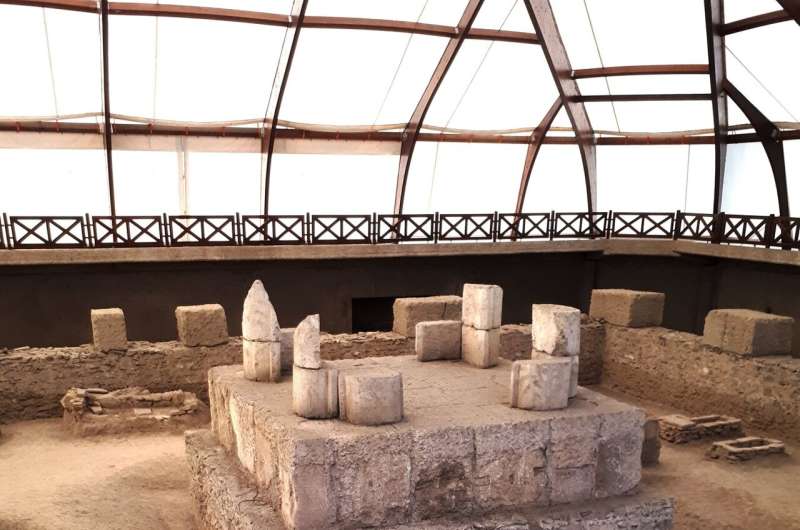
Mausoleum of Viminacium, which undoubtedly belonged to a very important individual. Archaeologists believe it could belong to Emperor Hostilian. © Carles Lalueza-Fox.
Bringing together historians, archaeologists, and geneticists
The study involved an interdisciplinary collaboration of over 70 researchers, including archaeologists who excavated the sites, anthropologists, historians and geneticists.
“This work exemplifies how genomic data can be useful for getting beyond contentious debates around identity and ancestry that have been inspired by historical narratives rooted in nascent nineteenth-century nationalisms and that have contributed to conflict in the past,” Lalueza-Fox said.
The team also generated genomic data from diverse present-day Serbs that could be compared with ancient genomes and other present-day groups from the region.
“We found there was no genomic database of modern Serbs. We therefore sampled people who self-identified as Serbs on the basis of shared cultural traits, even if they lived in different countries such as Serbia, Croatia, Montenegro or North Macedonia”, said co-author Miodrag Grbic, a professor at the University of Western Ontario, Canada.
Co-analyzing the data with that of other modern people in the region, as well as the ancient individuals, shows that the genomes of the Croats and Serbs are very similar, reflecting shared heritage with similar proportions of Slavic and local Balkan ancestry.
“Ancient DNA analysis can contribute, when analyzed together with archaeological data and historical records, to a richer understanding of the history of Balkans history,” said Grbic.
“The picture that emerges is not of division, but of shared history. The people of the Iron Age throughout the Balkans were similarly impacted by migration during the time of the Roman Empire, and by Slavic migration later on. Together, these influences resulted in the genetic profile of the modern Balkans—regardless of national boundaries.”
More information:
A Genetic History of the Balkans from Roman Frontier to Slavic Migrations, Cell (2023). DOI: 10.1016/j.cell.2023.10.018. www.cell.com/cell/fulltext/S0092-8674(23)01135-2
Provided by
University of Oklahoma
Citation:
Ancient Balkan genomes trace the rise and fall of Roman Empire’s frontier, reveal Slavic migrations (2023, December 7)
